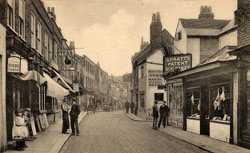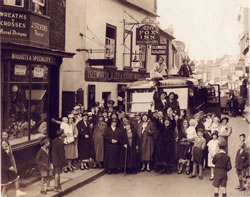Church Street
An ancient thoroughfare
1600

The principal way through Twickenham
Church Street took its name from St Mary's Church which was, and remains, its focal point on the bend at the top of Church Lane. For those who chose to travel by land it was the principal way through Twickenham for travellers between Richmond and the West. This traffic increased when Richmond Bridge was built in 1777 and in 1899 York Street was opened, so easing vehicle traffic along Church Street and reducing its importance.
When the monarch passed through Twickenham, going to Hampton Court, Church Street (if not the river) might have offered passage and the bells of St Mary's Church rung, or the parish fined if they did not sound...

Twickenham Manor HouseThe Manor House, later known as Arragon Towers, stood diagonally opposite the church, with its park extending to the north, nearly as far as the modern railway.
The first reference to Twickenham Manor itself is in a deed of 1446 recording a sale of land to William Yorke and his wife Agnes. This family had been connected with Twickenham from 1381 but it can only be supposition that they lived in the Manor House at this time. It is likely that the house was in existence from the beginning of the 16th century and its remains were finally demolished in 1934. According to a contemporary report Tudor bricks were recovered and sent to Hampton Court Palace and coins, one dated 1240 found.
1716 - Paving the street
Perhaps the most remarkable event to have taken place in Church Street was the paving of the street early in 1716 with stone taken from the churchyard. This stone was almost certainly masonry rubble from the collapsed nave for which no other use had been found while rebuilding the church in 1714.The work to be undertaken, confirmed in the minutes of Vestry for 25 January 1715/16, was for laying 360 square yards at 3d per yard and extended from the north of the churchyard up to the Cross at the top of the street.

Trade and commerce
The history of Church Street and the properties which line it today is a microcosm of the commercial and trading history of Twickenham. Families lived and worked here for generations: the families of Davies (butchers), Holmes (builders), Mesley (shoemakers), Morris (bakers), Reeves (bricklayers), Knott and Cripple (publicans) among them. These people are documented in the manorial and parish records although many others are unrecorded.

Ancient History
Archaeological excavation in the car park at the lower end of Church Street, in 1966 confirmed earlier settlement of the area c3000 BC. Mesolithic and Neolithic flints and pottery were found in a watercourse crossing the upper end of the car park. There may have been a causeway here leading to a settlement on Eel Pie Island.
Further reading:
E A Morris and THR Cashmore, Church Street - Twickenham, Borough of Twickenham Local History Society Occasional Paper No7, 1999
A C B Urwin, The Manor House Twickenham, Borough of Twickenham Local History Paper No60, 1987
R Sanford, Excavation in Church Street Twickenham 1966, Borough of Twickenham Local History Society Paper No12, 1968
Bygone Twickenham, Borough of Twickenham Local History Society, 1983
Donald Simpson (ed). Twickenham Past, Historical Publications, 1993




